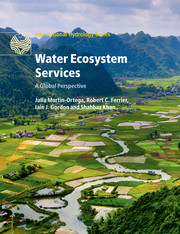Book contents
- Frontmatter
- Contents
- List of contributors
- Preface
- 1 Introduction
- 2 What defines ecosystem services-based approaches?
- Part I Addressing global challenges
- Part II Applying frameworks for water management and biodiversity conservation under an ecosystem services-based approach
- Part III Assessing water ecosystem services
- Part IV Broadening the perspective
- 15 Ecosystem services-based approaches to water management: what opportunities and challenges for business?
- 16 Key factors for successful application of ecosystem services-based approaches to water resources management: the role of stakeholder participation
- 17 Cultural ecosystem services, water, and aquatic environments
- 18 The psychological dimension of water ecosystem services
- 19 The interface between human rights and ecosystem services
- 20 Water ecosystem services: moving forward
- Index
- Plate Section
- References
15 - Ecosystem services-based approaches to water management: what opportunities and challenges for business?
from Part IV - Broadening the perspective
Published online by Cambridge University Press: 05 May 2015
- Frontmatter
- Contents
- List of contributors
- Preface
- 1 Introduction
- 2 What defines ecosystem services-based approaches?
- Part I Addressing global challenges
- Part II Applying frameworks for water management and biodiversity conservation under an ecosystem services-based approach
- Part III Assessing water ecosystem services
- Part IV Broadening the perspective
- 15 Ecosystem services-based approaches to water management: what opportunities and challenges for business?
- 16 Key factors for successful application of ecosystem services-based approaches to water resources management: the role of stakeholder participation
- 17 Cultural ecosystem services, water, and aquatic environments
- 18 The psychological dimension of water ecosystem services
- 19 The interface between human rights and ecosystem services
- 20 Water ecosystem services: moving forward
- Index
- Plate Section
- References
Summary
15.1 INTRODUCTION
Water sourcing, use, and discharge management have become critical issues to numerous business activities throughout the world. For instance, securing water supply is critical to farming and food production (e.g. World Water Assessment Programme 2014), while increasing water use and pollution are starting to generate severe operational, investment, and reputational risks for the agribusiness, mining, industrial, and financial sectors (e.g. Gulati 2014; von Bormann 2014; Bizikova et al. 2014).
Increasing research and funding is being dedicated to the link between ecosystem services and business. For example, in the UK the 2011 Natural Environment White Paper contained a commitment to establish a business-led Ecosystem Markets Task Force to review the opportunities for UK business from expanding green goods, services, products, investment vehicles, and markets which value and protect nature's services. Business and ecosystem services are the central focus of several professional networks including the Business for Social Responsibility's Ecosystem Services Working Group and the World Business Council for Sustainable Development's Ecosystems Focus Area (for a more extensive list, see Hanson et al. 2008; Waage & Kester 2014). As well as an increase in recruitment demanding business expertise in ecosystem services, a body of literature is developing to aid businesses to integrate ecosystem services into existing performance systems (Houdet et al. 2012).
Though most firms depend and/or impact, to varying extents, on the various provisioning, regulating, and cultural ecosystem services derived from aquatic ecosystems, applying an ecosystem services-based approach to their uses of water presents both opportunities and challenges. The aim in this chapter is threefold. First, we intend to explain the interdependency links (dependencies and impacts) between water ecosystem services and various business activities. In doing so, we discuss the main water ecosystem services risks for business activities, notably in terms of water scarcity, ageing water infrastructures, changing policy environments and regulatory frameworks, and reputation.
- Type
- Chapter
- Information
- Water Ecosystem ServicesA Global Perspective, pp. 129 - 137Publisher: Cambridge University PressPrint publication year: 2015

